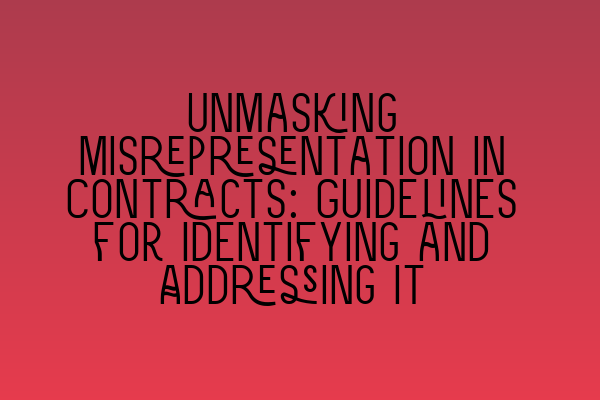Unmasking Misrepresentation in Contracts: Guidelines for Identifying and Addressing It
Contracts are the backbone of any legal transaction, providing a framework for parties to formalize their agreements. However, in the complex world of contract law, there is often a risk of misrepresentation. Misrepresentation occurs when one party makes a false statement or conceals relevant information during the negotiation process, leading the other party to enter into the contract under false pretenses.
In this article, we will explore the various types of misrepresentation that can occur in contracts, provide guidelines for identifying and addressing it, and discuss the legal implications for both parties involved. Understanding misrepresentation is crucial for solicitors and legal professionals to ensure the integrity of their practice and protect their clients’ interests.
Types of Misrepresentation
Misrepresentation can take several forms, each with its own legal implications. It is essential to recognize these different types to effectively identify and address misrepresentation in contracts.
1. Innocent Misrepresentation
Innocent misrepresentation occurs when a party makes a false statement innocently, without any intent to deceive. The misrepresenting party genuinely believes the statement to be true and is unaware of its falsity. Despite the lack of intent, innocent misrepresentation can still have legal consequences.
If innocent misrepresentation is proven, the innocent party may have the option to rescind the contract, seeking restitution or damages. However, the misrepresenting party may be able to defend their position if they can prove they had reasonable grounds to believe the statement was true at the time of making it.
2. Negligent Misrepresentation
Negligent misrepresentation occurs when a party makes a false statement without reasonable grounds for believing it to be true. Unlike innocent misrepresentation, the misrepresenting party acts negligently by failing to exercise due diligence in verifying the accuracy of the statement.
If the innocent party can prove that the misrepresentation was made negligently, they may have the right to seek damages or rescind the contract. However, the burden of proof lies with the innocent party, and they must demonstrate that they relied on the false statement and suffered a loss as a result.
3. Fraudulent Misrepresentation
Fraudulent misrepresentation is the most severe form of misrepresentation, involving intentional deception and dishonesty. It occurs when a party knowingly makes a false statement with the intent to deceive the other party and induce them to enter into the contract.
If fraudulent misrepresentation is proven, the innocent party can not only seek rescission, restitution, or damages but may also have an additional claim for fraudulent conduct. Fraudulent misrepresentation can have serious legal consequences for the misrepresenting party, including potential criminal liabilities.
Identifying Misrepresentation
Identifying misrepresentation requires a thorough examination of the facts, statements, and circumstances surrounding the contract. Here are some key guidelines to assist solicitors in identifying potential misrepresentation:
- Review the contractual documents carefully, paying attention to any discrepancies, inconsistencies, or ambiguities.
- Interview the parties involved to understand their intentions and the representations made during the negotiation process.
- Examine supporting documents, such as emails, letters, or other correspondence, for any evidence of false statements or omissions.
- Consult experts in relevant fields to analyze technical or specialized information that may be crucial to the contract.
- Consider conducting background checks on the parties involved to uncover any previous instances of misrepresentation or fraudulent behavior.
- Seek legal advice from experienced contract law specialists to ensure a comprehensive evaluation of the contract and any potential misrepresentation.
By following these guidelines, solicitors can effectively uncover misrepresentation in contracts and protect their clients’ interests.
Addressing Misrepresentation
Once misrepresentation is identified, it is crucial to take appropriate steps to address the issue. Here are some recommended actions solicitors can take:
- Communicate with the opposing party to bring the misrepresentation to their attention and discuss potential resolutions.
- Consider renegotiating the terms of the contract to rectify any imbalances caused by the misrepresentation.
- Advise the innocent party on their legal rights and options, such as seeking rescission, damages, or specific performance.
- Initiate legal proceedings, if necessary, to protect the innocent party’s interests and hold the misrepresenting party accountable.
- Seek guidance from the court or alternative dispute resolution methods to facilitate a fair and just resolution.
- Document all communications, actions, and evidence throughout the process to ensure a comprehensive record of the misrepresentation.
Proactively addressing misrepresentation helps solicitors maintain their professional integrity and uphold the principles of contract law.
Legal Implications
Misrepresentation can have significant legal implications for both parties involved in a contract. Depending on the type and severity of the misrepresentation, various remedies and consequences may apply:
- Rescission: The innocent party may seek to unwind the contract, returning both parties to their pre-contractual positions.
- Restitution: The innocent party may claim compensation for any losses suffered as a result of the misrepresentation.
- Damages: The innocent party may seek monetary compensation to cover the losses incurred due to the misrepresentation.
- Specific Performance: In certain cases, the innocent party may request the court to enforce the contract as originally intended, despite the misrepresentation.
- Fraud: If fraudulent misrepresentation is proven, the misrepresenting party may face criminal charges, fines, or other legal consequences.
It is crucial for solicitors to be well-versed in the legal implications of misrepresentation to protect their clients’ rights effectively.
In conclusion, misrepresentation in contracts is a critical issue that all solicitors must be vigilant about. By understanding the different types of misrepresentation and following the guidelines for identification and addressing, solicitors can protect their clients’ interests and uphold the integrity of contract law. Navigating the complexities of contract law and avoiding legal pitfalls are essential skills for solicitors to cultivate, ensuring the success of their practice and the satisfaction of their clients.
Related Articles:
- Navigating Legal Challenges and Pitfalls in Your Practice
- Ethical Responsibilities of Solicitors: Upholding Professionalism
- Barrister vs. Solicitor: A Comprehensive Comparison
- Understanding the SRA Competence Statement: A Guide for Solicitors
- Networking for Solicitors: Strategies for Building a Strong Network
